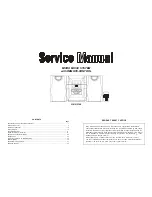
19
Owner’s Manual
Owner’
s Manual
Another way to consider low cut’s function is that it
actually adds fl exibility during live performances. With
the addition of low cut, you can safely use low EQ on
vocals. Many times, bass shelving EQ can really ben-
efi t voices. Trouble is, adding low EQ also boosts stage
rumble, mic handling clunks and breath pops. Low cut
removes all these problems so you can add low EQ with-
out losing a woofer out the window.
3-BAND EQ
The ProFX mixer has 3-band equalization at carefully
selected points — low shelving at 80 Hz, mid peaking at
2.5 kHz, and high shelving at 12 kHz. “Shelving” means
that the circuitry boosts or cuts all frequencies past the
specifi ed frequency. For example, rotating the low EQ
knob 15 dB to the right boosts bass starting at 80 Hz and
continuing down to the lowest note you never heard.
“Peaking” means that certain frequencies form a “hill”
around the center frequency — 2.5 kHz in the case of
the mid EQ.
The following graphs of frequency vs. signal level show
the approximate overall effect of EQ adjustment on the
frequency range.
23. HI EQ
This control gives you
up to 15 dB boost or cut
above 12 kHz, and it is fl at
(no boost or cut) at the
detent. Use it to add sizzle
to cymbals, and an overall
sense of transparency, or
edge to keyboards, vocals,
guitar and bacon frying. Turn
it down a little to reduce sibilance, or to hide tape hiss.
24. MID EQ
Short for “midrange,”
this knob provides 15 dB
of boost or cut, centered at
2.5 kHz, also fl at at the cen-
ter detent. Midrange EQ
is often thought of as the
most dynamic, because the
frequencies that defi ne any
particular sound are almost always found in this range.
You can create many interesting and useful EQ changes
by turning this knob down as well as up.
25. LOW EQ
This control gives you up
to 15 dB boost or cut below
80 Hz. The circuit is fl at at
the center detent position.
This frequency represents
the punch in bass drums,
bass guitar, fat synth
patches, and some really
serious male singers.
Used in conjunction with
the low cut [22] switch,
you can boost the low EQ
without injecting a ton of
subsonic debris into the
mix.
MODERATION DURING EQ
With EQ, you can also upset things royally. We’ve de-
signed a lot of boost and cut into each equalizer circuit,
because we know everyone will occasionally need that.
But if you max the EQs on every channel, you’ll get mix
mush. Equalize subtly and use the left sides of the knobs
(cut), as well as the right (boost). Very few gold-record-
album engineers ever use more than about 3 dB of EQ.
If you need more than that, there’s usually a better way
to get it, such as placing a mic differently (or using a
different kind of mic entirely).
26. AUX MON
These knobs tap a portion of each channel's signal
to set up a nice monitor mix feeding stage monitors,
independent of the main mix. Adjust these controls on
each channel until your band is happy with the stage
monitor mix.
The aux mon feed from hybrid and stereo channels is
a mono sum of the left and right sides of these channels.
The controls are off when turned fully down, deliver
unity gain at the center detent, and can provide up to 15
dB of gain turned fully up.
The channel fader [31], pan [28], or mute [30] do
not affect the monitor output, but the other channel
controls will. (The aux mon is pre-fader.)
The monitor signal from the monitor output jack [13]
is the sum (mix) of all the channels whose aux mon
control is set to more than minimum. The overall output
level can be adjusted with the monitor fader [47] and
its EQ tweaked with the graphic EQ [37] if the main
mix/mon switch [38] is pressed in. Internal FX can also
be added to the monitor mix with the FX to mon knob
[54].
20
Hz
100
Hz
1k
Hz
10k
Hz
20k
Hz
–15
–10
–5
0
+5
+10
+15
Mid EQ
20
Hz
100
Hz
1k
Hz
10k
Hz
20k
Hz
–15
–10
–5
0
+5
+10
+15
20
Hz
100
Hz
1k
Hz
10k
Hz
20k
Hz
–15
–10
–5
0
+5
+10
+15
Low EQ with Low Cut
Low EQ
20
Hz
100
Hz
1k
Hz
10k
Hz
20k
Hz
–15
–10
–5
0
+5
+10
+15
High EQ
















































